Black Summer bushfires: 5 NSW south coast families open up on trauma
From the grief of losing loved ones to rebuilding homes and starting lives over, the pain of the Black Summer bushfires is very real on the south coast of NSW. Five families share their stories.
NSW
Don't miss out on the headlines from NSW. Followed categories will be added to My News.
On New Year’s Eve 2019, the inferno reached the south coast of NSW.
From Milton to Eden, hundreds of homes burned to the ground, residents were forced to flee with only the clothes on their backs and eight people were killed.
Over the past 12 months, families have faced the difficult task of rebuilding their lives and starting again.
These are their stories.
Rebuild red tape fails a mum and daughter ‘just surviving’
Veronica Coen, Quaama
Last Christmas Veronica Coen and her family enjoyed lunch on her newly-constructed deck overlooking dry bushland in the quaint town of Quaama.
The social worker had just finished renovating her home and was thrilled to have her five children and grandkids over for the holidays.
Next week, she will host Christmas again but under a gazebo on a vacant block where her dream home used to be. Ms Coen’s 100-year-old Blacksmith cottage was razed last New Year’s Eve when fire tore through the Bega Valley in the early hours of the morning. The 60-year-old lost almost everything.
A few ceramics and a baby chicken that emerged from the ashes were the only things to survive. Ms Coen aptly named the chick “Miracle”.

Almost 12 months on, Ms Coen and her daughter Kara O’Grady-Coen are still living in an old bus and a small caravan on the property as they wait for a builder to become available and start construction on their home.
“All the ongoing experience of the trauma, it’s not like the fire is gone and we all move on,” Ms Coen said.
“We are still surviving. The term recovery, it doesn’t feel like recovery.”
An old water tank is now a makeshift bathroom. Ms Coen could use the recovery pod, provided by the NSW Government to bushfire victims in September, but she prefers the view over the trees from the water tank.
The past year has been tough on Ms Coen and Kara but the women are remarkably resilient. The stress of losing everything contributed to the breakdown of Ms Coen’s relationship, she said.
While the bakery in the centre of Quaama where Kara worked was a lifeline for locals and emergency services immediately after the bushfires, it was forced to lay off staff when the pandemic began.
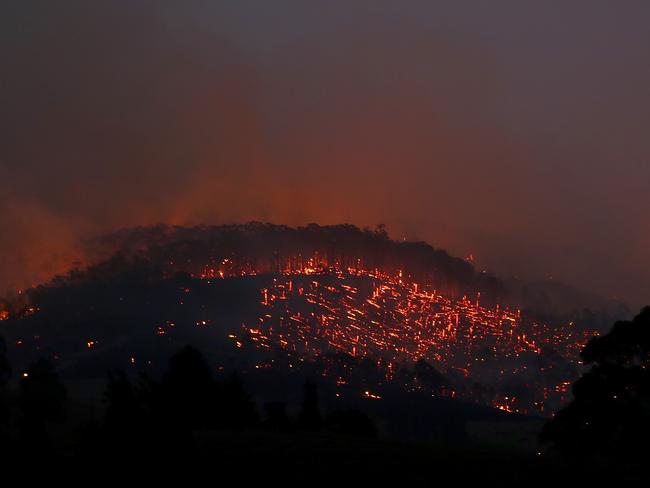
A gifted artist, Kara’s creativity has suffered too. She hasn’t painted a brushstroke since the fire destroyed her mother’s home and every reminder of her childhood. Much of her day is spent calling builders, requesting quotes, dealing with an architect who has kindly donated his time to drafting plans for their future home and researching building regulations for bushfire-prone areas.
The house was covered by insurance but with 465 homes lost across the Bega Valley area, the demand for tradesmen is high. Ms Coen believes she won’t make the first deadline for the Federal Government’s HomeBuilder Grant and was disappointed to learn while the program was extended, it was at a lower rate of $15,000 – reduced from $25,000. It is a problem bushfire victims up and down the East Coast face.
New building codes for construction in bushfire prone areas and lengthy waiting times for tradesmen and council approvals has added to the development application process. The grant is only available to people who have signed a contract with a builder. Ms Coen fears she wouldn’t make the December cut off to be eligible for the $25,000 grant by no fault of her own.
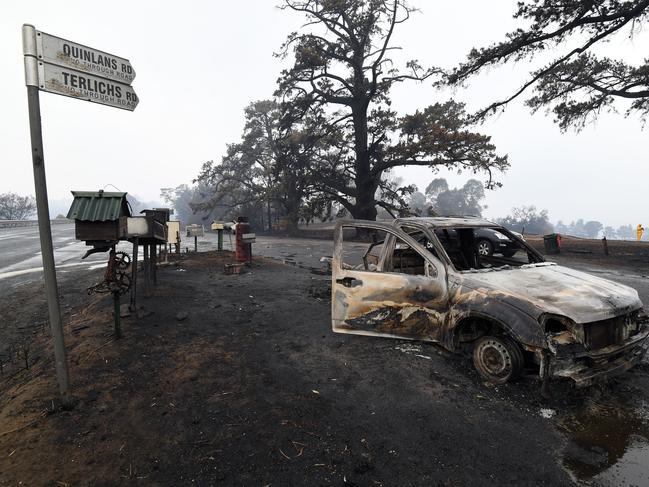
“It’s not at all thought out in terms of the needs of people,” said Ms Coen, who has sought quotes from three separate builders.
It is not the material losses that hurt that most but the “reference points for my story, who I am, where I’ve come from and my children”.
The impact on Quaama, where 30 homes were lost, has been unrelenting. Relationships have ended, livestock and livelihoods have been lost and Ms Coen says she knows one person who has committed suicide. But the shining light has been the community spirit and the generosity of complete strangers.
The mother and daughter hope to see the first sod turned on their home in early 2021.
“I don’t like the term recovery because it implies going back to the way things were,” Ms Coen said. “I don’t think any of us ever will.”
‘We lost John but we still have each other’
Josie Smith, Nerrigundah
Josie Smith remembers the first time she visited her husband’s property in Nerrigundah.
Lush green bushland on the edge of the Tuross River, gently swaying trees and a beautiful homestead.
“It was paradise,” Mrs Smith remembers.
To her 11-year-old daughter Emerald, the property “in the bush” was her fairyland.
But what for a long time was a source of happiness became a source of pain on New Year’s Eve 2019.
Mrs Smith’s husband of 11 years and Emerald’s father, engineer and TAFE teacher John Smith, died trying to defend his property from a fierce bushfire.

“I was begging him to come back at night and he said ‘I’ll come back as early as I can’,” a teary Mrs Smith recalled.
A day earlier, Mr Smith travelled to Nerrigundah from the family’s permanent residence in Catalina near Bateman’s Bay.
The 71-year-old planned to clear firewood that was piled up on the deck in a futile attempt to prepare for the fire front.
Mrs Smith didn’t sleep well that night and dreamt of her husband apologising to her repeatedly.
In the morning, on New Year’s Eve, Mrs Smith woke up and checked the Rural Fire Service app.
It showed the fire spread across Nerrigundah.
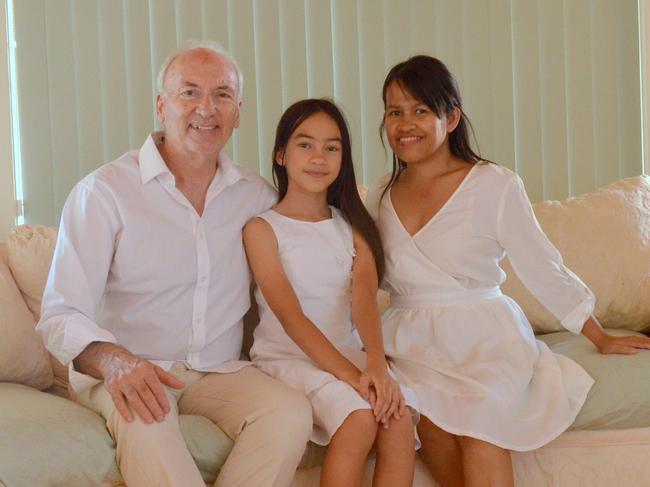
She called her husband again and again but there was no answer.
Then Mrs Smith and Emerald were forced to flee their Catalina home for an evacuation centre as flames licked at their back fence. It would be weeks before they could return.
Mrs Smith called triple-0 repeatedly but was told the area Mr Smith was in was inaccessible to emergency crews.
It was six days before a neighbour gained access to the property and found his body a few hundred metres from the homestead.
The only thing that survived the inferno was a chinaware dinner set.
After Mr Smith’s death, their Nerringundah property felt different and in October, they put it on the market.
“I sold it to a person we know and they said we can visit whenever we like,” Mrs Smith said.
“It didn’t have the beauty like it had before.”

Over the past 12 months, Mrs Smith has struggled with the social isolation imposed by COVID-19 and the trauma of losing her husband.
The sight of burned land or trees up and down the far south coast was a trigger.
In her mind, she’d imagine her husband’s body on the blackened grass.
“We lost so much,” said Mrs Smith, who has been treated for post traumatic stress disorder.
“Our weekend getaway that was like a paradise, a house, an art studio and paintings inside but losing John is like losing everything.
“But Emerald is always reminding me that we still have each other.
“We may have lost her Daddy but we still have each other and that‘s more than enough to thank for.”
Displaying a maturity beyond her young years, Emerald said she was too preoccupied with her mum to worry about her own grief.
“I was more worried about mum and how she was because she was locked up in her room a lot,” she said.
Emerald became a social media sensation last year when she used gift cards she received for her 10th birthday to buy treats for the Long Beach RFS brigade.
She wrote personalised messages thanking the fireys for “saving our lives” on every brown paper bag.
Fire sounded ‘like 1000 whips cracking’
Arlo Ireland, Jeremadra
When the Currowan fire bore down on the tiny community of Jeremadra, Arlo Ireland was prepared. The land was “as dry as a biscuit” and Mr Ireland had spent months preparing for the bushfire season.
By New Year’s Eve 2019, he had 120,000 litres of water, three water pumps strategically placed around his property, 160 metres of cleared land surrounding his home and as last resorts, a pool and a below ground bunker.
“I didn’t expect to lose the place because we had such a defendable position,” he said.
“Any other day we would’ve been fine – just not that day. It wasn’t going to happen.”
At 5.30am on December 31, 2019, as plumes of orange smoke hovered over Runnyford to the west, Mr Ireland asked his wife, Bec, and two sons, Harper, 9, and Sullivan, 7, to leave.
The family, who had only purchased the Jeremadra property 18 months earlier, packed the car and headed to Moruya. His wife called in tears on the phone begging him to leave.
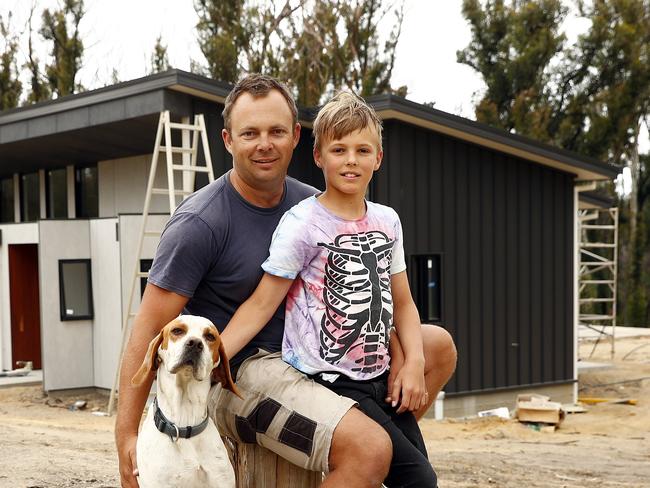
Mr Ireland stayed, moving the pumps around the property in the hope they’d be where the flames would be.
But when the fire front finally reached the southern edge of his boundary and soared 120 feet above the tree canopy, Mr Ireland knew it was hopeless.
“For hours it sounded like jet engines but when it came across the highway it was like 1000 whips cracking,” he said.
Mr Ireland jumped in his car, floored it down the Princes Highway through the smoke until he reached his neighbour’s property two kilometres down the road.
The Ireland’s cedar homestead burned to the ground in 11 minutes.
Even the steel combustion stove, which was meant to withstand temperatures of up to 1000C, melted.
Mr Ireland returned to the property 20 minutes after the front had passed through.
“Nothing survived in the house,” he said. “I left the car here, a tractor and a ride-on a lawnmower and parked it down the paddock – that survived. And five chickens.”

Mr Ireland, his wife and kids had each grabbed a suitcase before leaving the home with the clothes on their backs.
Despite the enormous loss, Mr and Mrs Ireland saw the fire damage as an opportunity to start afresh.
“Even the day when I came back and saw the house gone, it felt OK to see what we had left – the water tank, the fencing, seeing where our clean start was,” he said.
“Next day I brought Bec and the kids out. The kids were amazing. They have been our strength I reckon.
“Bec and I have had some hard times but I think between the two of us, always one of us is all right.”
More than 500 homes were destroyed in the Eurobodalla Shire Council area alone and 79 per cent of the shire was impacted by fire.
Mr Ireland, who is a safety officer with NSW Maritime Services, and Mrs Ireland, a town planner, predicted the high demand for temporary accommodation and tradesman to rebuild.
They ordered a portable home 72 hours after the fire – after a kind stranger offered up her holiday unit on the coast for the family to stay in for almost three months.
With the help of tradie mates and family, the Irelands cleared most of the scrap metal and debris on their property.
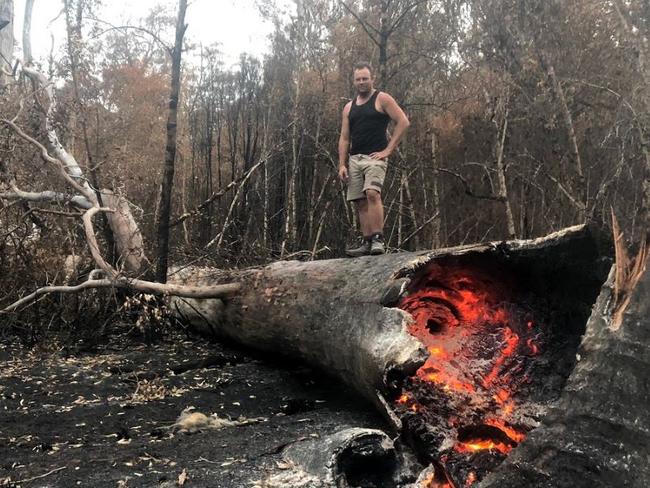
In July, construction began on the new home, which looks out across rows of towering, blackened trees.
The family expects to move in this weekend — just in time for relatives fresh out of lockdown in Victoria to arrive for Christmas lunch.
The biggest challenge for the Irelands rebuilding their home has been with the Commonwealth Bank.
Mr Ireland said CBA offered him a 12-month interest and repayment free plan rather than clearing his debt and re-borrowing. He agreed.
But a glitch in the bank’s computer system falsely reported Mr Ireland as defaulting on his loan repayments every month.
“That took months to fix and now it keeps happening every month,” he said.
He only picked up on it when he applied for finance for a car and realised his historically-perfect credit rating was through the floor.
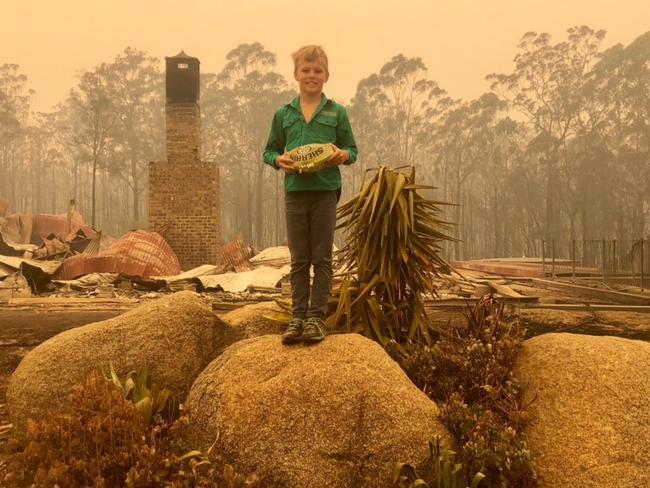
“When we were homeschooling our kids during COVID I couldn’t get a new Telstra Wi-Fi because I had no credit rating,” he said.
“Any other time I would have left the bank but I can’t go to another bank as they had falsely reported our credit rating. It has been a nightmare.”
Mr Ireland stresses that he was fortunate enough to have the means and skills to kick off his rebuild in July but other families who lost their homes were in different positions. Some of his neighbours are still living in caravans.
However, the trauma of the bushfire has brought this pocket of Jeremadra closer together. Neighbours who Mr Ireland only used to waved at in the street now come over for Friday night beers and have helped with the construction of his home.
While the portable home the family lived in for 11 months was meant to be a temporary solution, Mr Ireland said the structure is there to stay for friends and family.
“We had a lot of generous friends helping us over the past year,” he said. “So our idea is that whoever wants to visit or anyone in need, after all the generosity we have been shown, we will pass it on as much as we possibly can.”
‘Everyone just wishes New Year’s Eve will go away’
Kim Harper, Conjola Park
Kim Harper found herself in tears when the acrid smell of bushfire smoke wafted across her property recently.
“You could see the smoke and ash falling,” she recalled.
It turned out to be a neighbour carrying out a hazard reduction burn – with a permit – but for Ms Harper it was a trigger.
A reminder of the horror that ripped through Lake Conjola and Conjola Park last New Year’s Eve.
And there are plenty of them. — the charred forest Ms Harper can see from her balcony, which is still under construction after being burned in the fire almost 12 months ago; the empty block next door and next door to that.; the elderly residents who packed up and left for good; the sound of backhoes and excavators working on the house rebuild down the road.
“We are the third house from the highway,” she said.
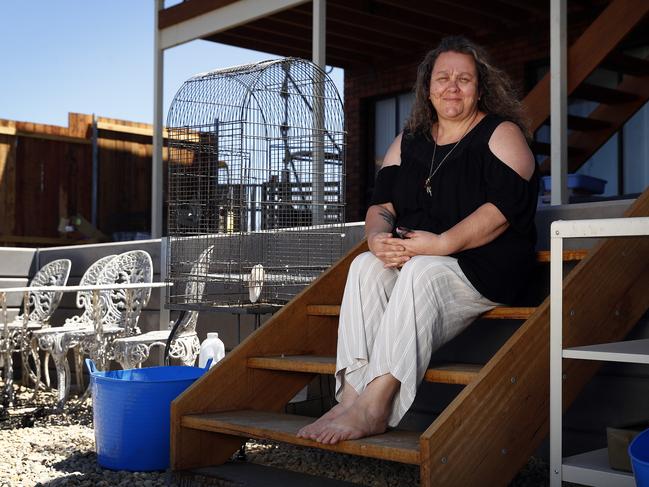
“We used to be the 11th.”
Ms Harper moved into her mother’s Conjola Park home in early 2019 after her father died from cancer.
On New Year’s Eve last year, as the Currowan fire edged closer to the coast, Ms Harper and her mother, 84-year-old Elaine, decided to leave.
Her partner planned to stay and defend the home Elaine had lived in for 35 years but when he turned the hose on, no water came out. When they returned after the fire passed through, turning off the Princes Highway and onto Lake Conjola Entrance Road, their house was one of the few that was left standing.
Elaine’s lush garden, including an orchid she saved from her wedding bouquet 60 years ago, was incinerated.
The back windows melted and the car and boat were gone.
“I tell everyone it was Dad on top of our house with a hose that day,” she said.
The Wreck Bay Rural Fire Service brigade also had something to do with it and used water filled buckets to douse the flames and save Ms Harper’s home.
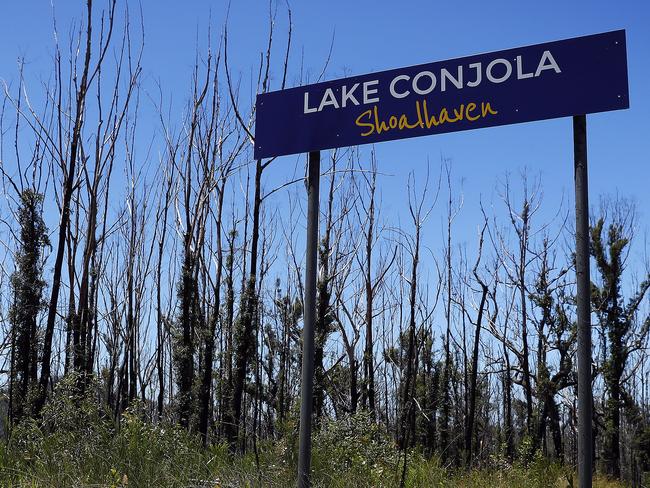
It was strange to assess what the fire had spared. The next door neighbour’s home burned to the ground. But two wheelbarrows, one child sized and one adult sized, that a father and son pushed around the backyard everyday were untouched. Almost 90 homes were destroyed in Conjola Park that day.
Ms Harper, her partner and mother only just moved back into their home, with sweeping views over Conjola Lake, two weeks ago.
There was a hold up because it was unclear whether the house needed to be demolished because of the damage and asbestos material.
They stayed at Sussex Inlet in emergency accommodation until they begged to be able to return home.
They didn’t care if there was still minor work to be done. They wanted their old roof over their heads.
While the 12 month anniversary of the bushfires just around the corner, Ms Harper said the community has opted not to commemorate it. They will hold an event in March instead.
“They are stressed and trying to get back on their properties,” she said.
“Everyone just wishes NYE will go away.”
Optimism amid bureaucracy, delays and a real estate boom
Dan Jansch, Conjola
Dan Jansch is living in a small portable home.
His house burned down in the bushfires last New Year’s Eve while he sheltered in a dam under a wet blanket.
At the time he was setting up his own auto wreckers business on his Conjola property.
The 35 cars he had collected, some prized vintage makes and models, were also destroyed.
As was a large truck worth about $50,000.
He had no insurance because he hadn’t settled on the property yet.
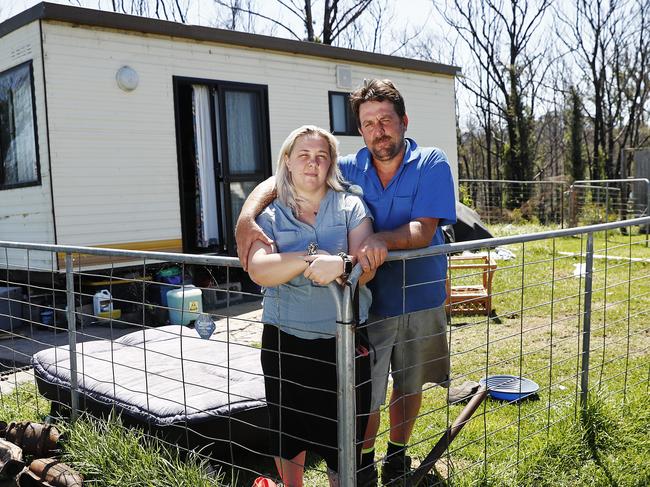
And now he is being strangled in bureaucratic red tape as he tries to rebuild his life on the same block of land.
“There are a lot of people worse off than us,” Mr Jansch said.
It is a statement that is repeated in fire-affected communities up and down the NSW south coast from Milton to Eden.
Everyone is acutely aware of everyone else’s struggles.
There is a feeling of fortune over their own survival, no matter how dire their situation appears to outsiders.
On New Year’s Eve, Jansch and his girlfriend, Alisha Stoneham, stayed on Lake Conjola Entrance Road to defend their five acre property.
Jansch moved cars to different spots in the neighbourhood in the hope at least one or two would survive the impending inferno.
The couple stayed until the street was literally ablaze and houses were exploding.
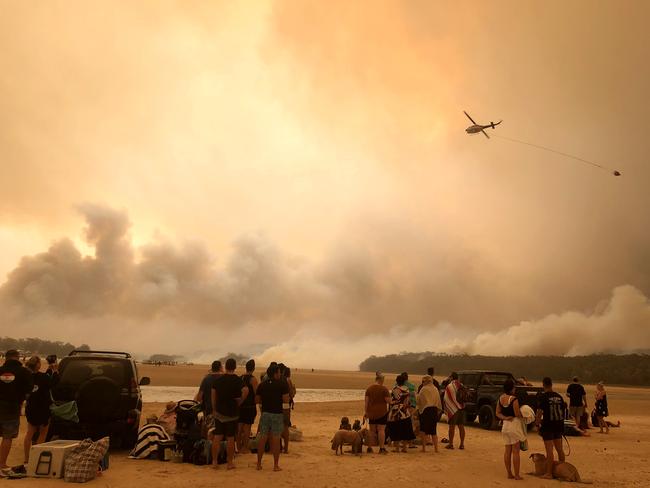
“We were driving down the street and all the houses were on fire,” Mr Jansch said.
In the final minutes, they grabbed a wet blanket and their dog Ruby and headed for a dam on a friend’s property down the road.
“He was planning to go to the lake but we couldn’t get there because houses all around were burning and power lines were down,” Ms Stoneham said.
They hid there for 20 minutes as the fire front passed through, wondering if they would suffocate in the smoke and heat.
When they emerged from the water and went back to their property, everything was flattened.
“It took almost eight months to get cleaned up,” Mr Jansch said of the aftermath. “It was an old building and it had all the fry-able goodness.”
Mr Jansch said there seemed to be no real urgency from contractors to clean up some properties, including his, even though there was asbestos material scattered around.
He believes it was the reason his dog, Ruby, died after sniffing around in the contaminated debris.
He ended up doing most of the 150 tonne clean up himself before bushfire recovery contractor Laing O’Rourke came through in August
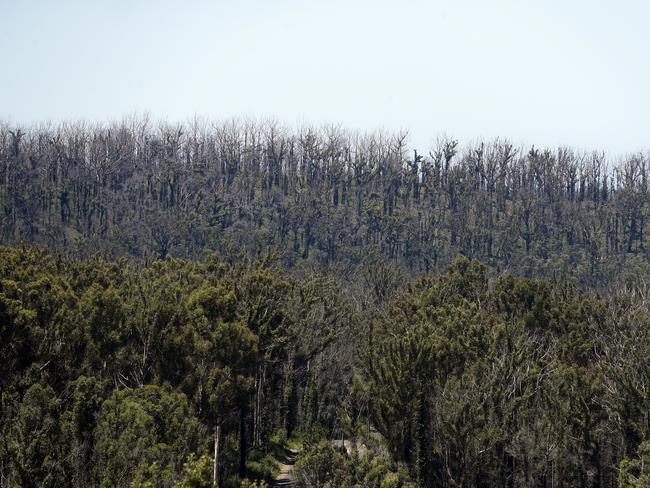
Mr Jansch planned on eventually buying the property but he discovered a 2016 Local Environmental Plan prevented the construction of a dwelling house on land under 100 acres and zoned as rural primary production.
The previous structure was built under a development application approved in 1975 – outside of the LEP’s reach.
The council can give consent but it’s not a sure thing and Mr Jansch doesn’t want to buy the property if there is a chance he can’t make it a home. The confounding thing is, the blocks across the road are zoned semi rural.
By the time Mr Jansch started looking to buy elsewhere, the pandemic was driving Sydneysiders into the regions.
“Since the fires, property prices around here have gone through the roof,” he said.
“We’ve got this portable home while we figure out what to do.”
This time of year, the hot weather, the strong westerlies, reminds him of the catastrophe that had him sheltering in a dam almost a year ago.
But Christmas Day won’t be clouded in smoke this year.
It’ll be spent at Mr Jansch’s parents’ place at Sussex Inlet.
“Getting pissed, eat plenty of seafood, a few swims and just make the most of it,” the optimist said.





